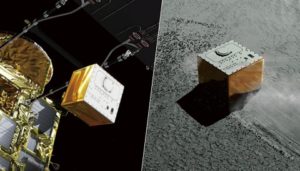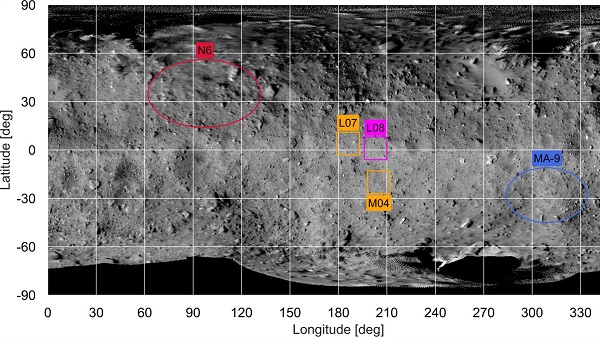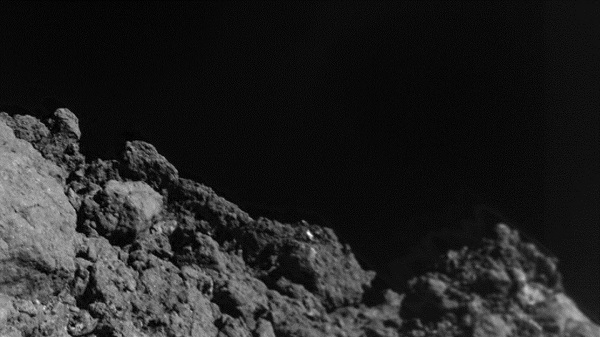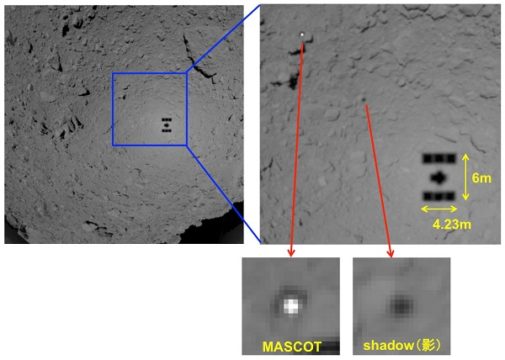The joint DLR-CNES asteroid lander MASCOT dispatched by JAXA's Hayabusa-2 completes its mission.

JAXA
Tiny asteroid 162173 Ryugu has had lots of visitors as of late. First, the ground-breaking MINERVA IIA and MINERVA IIB “asteroid hoppers” made their way to the surface in September 2018. Now, another larger lander has successfully made its descent onto the alien world, as the Mobile Asteroid Surface Scout (MASCOT) mission completed its short frenzied mission of exploration last week.
Built by the German Aerospace Center (DLR) in partnership with the French CNES Space Agency, MASCOT is powered by a 200-watt-hour battery and meant to operate only for 16 hours, though it actually lasted for 17 hours before falling silent.
“With MASCOT, it has been possible to, for the first time, explore the surface of an asteroid directly on site,” said Hansjörg Dittus (DLR) in a recent press release. “A mission like this can only be done working in close cooperation with international partners, bringing together all their expertise and commitment.”
The adventure started on October 3rd at 1:57 Universal Time (UT), when the Japanese Space Agency's (JAXA) Hayabusa 2 descended to within just 51 meters from the surface of Ryugu and released MASCOT for a short free fall under the feeble gravitational pull of the asteroid to its surface.

JAXA
Weighing 21 pounds (9.6 kilograms), breadbox-sized MASCOT measures 29.5 cm x 27.5 cm x 19.5 cm (12″ x 11″ x 8″). There are four scientific instruments aboard the tiny spacecraft: a radiometer and camera (MASCAM) built by DLR, an infrared spectrometer (MicrOmega) supplied by CNES's Institut d'Astrophysique Spatiale, and a magnetometer supplied by TU Braunschweig.
The radiometer aboard MASCOT was actually based on a similar instrument, also built by DLR, aboard NASA's Mars InSight mission set to land on Mars on November 26, 2018.

JAXA
A Hectic Period of Exploration
MASCOT successfully came to rest on Ryugu after a brief descent. But it took a few rotations of the lander's built-in mechanical swing arm to place it in a favorable orientation for observations. The lander was then able to take measurements over the span of one full day-and-night cycle on the asteroid, as it rotates once every 7 hours 36 minutes.
The first few maneuvers moved MASCOT a few meters away from its initial touchdown location. But seeing that the lander still had some power left, researchers dared to swing the arm one last time, making a longer jump. At the end of its mission, MASCOT had explored Ryugu for three days and two nights on the asteroid, taking readings of the asteroid's magnetic and gravitational field while snapping image sequences that will eventually be used to generate stereo images of the asteroid's surface once researchers analyze them.

MASCOT / DLR / JAXA
The first images from the surface of Ryugu taken by MASCOT show an ancient jumbled surface, a rubble pile from the early days of solar system formation.
“The evaluation of the valuable data has just begun,” said Tra-Mi Ho (DLR Institute of Space Systems) in a recent press release. “We will learn a lot about the past of the Solar System and the importance of near-Earth asteroids like Ryugu.”
All data from MASCOT were relayed to Earth,18 light-minutes away, via Hayabusa-2, which returned to a station-keeping position 20 kilometers (12 miles) from the asteroid's surface once it had deployed MASCOT.

JAXA
But MASCOT was the penultimate prelude to the mission's climax, as Hayabusa 2 makes one more touchdown rehearsal approach and then moves in for a series of sample collection maneuvers starting at the end of October 2018. Then, Hayabusa 2 will finish exploration of Ryugu and depart the asteroid in December 2019 and — if all goes according to plan — return the sample collection capsule to Earth in December 2020 along with its precious cargo.
Hayabusa 2 and its crew of robot hoppers have performed flawlessly thus far, as lessons learned from the earlier problematic Hayabusa mission to asteroid 25143 Itokawa are paid forward. MASCOT has now fallen silent on the surface of Ryugu, another testament to human exploration of the solar system.
 1
1









Comments
bwana
October 12, 2018 at 6:53 pm
An ambitious and well executed space program. Congrats to the participants!
You must be logged in to post a comment.
You must be logged in to post a comment.